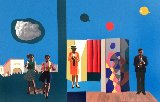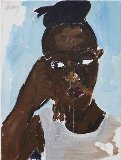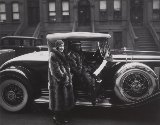-

-
Glen Ligon
United StatesArt Brokerage: Glen Ligon African-American Artist: b. 1960. Born in 1960 in the Bronx, he graduated with a B.A. from Wesleyan University. He works in multiple media, including painting, neon, video, photography, and digital media such as Adobe Flash for his work Annotations Glen Ligon. Ligon's work is greatly informed by his experiences as an African American and as a gay man living in the United States. In 1989, he mounted his first solo show, "How It Feels to Be Colored Me," in Brooklyn. This show established Ligon's reputation for creating large, text-based paintings in which a phrase chosen from literature or other sources is repeated over and over, eventually dissipating into murk.rnrnIn 1994, the art installation "To Disembark" was shown at the Hirshhorn Museum and Sculpture Garden in Washington, D.C. The title alludes to the title of a book of poetry by Gwendolyn Brooks. "To Disembark" functions in both works to evoke the recognition that African Americans are still coping with the remnants of slavery and its ongoing manifestation in racism. In one part of the installation, Ligon created a series of packing crates modeled on the one described by ex-slave Henry "Box" Brown in his "Narrative of Henry Box Brown who escaped from Slavery Enclosed in a Box 3 Feet Long and 2 Wide." Each crate played a different sound, such as a heartbeat, a spiritual, or contemporary rap music. Around each box, the artist placed posters in which he characterized himself, in words and period images, as a runaway slave in the style of 19th century broadsheets circulated to advertise for the return of fugitive slaves. In another part of the exhibition, Ligon stenciled four quotes from a Zora Neale Hurston essay, "how it feels to be colored me," directly on the walls: "I feel most colored when I am thrown against a sharp white background," "I remember the very day that I became colored," "I am not tragically colored," and "I do not always feel colored." Ligon found Hurston's writing illuminating because she explores the idea of race as a concept that is structured by context rather than essence."A Feast of Scraps" he inserted pornographic and stereotypical photographs of black men, complete with invented captions ("mother knew," "I fell out" "It's a process") into albums of family snapshots including graduation photographs, vacation snapshots, pictures of baby showers, birthday celebrations, and baptisms, some of which include the artist's own family. Like almost all of Ligon's art, this project draws out the secret histories and submerged meanings of inherited texts and images. Another series of large paintings was based on children's interpretations of 1970s black-history coloring books. In 2005, Ligon won an Alphonse Fletcher Foundation Fellowship for his art work. In 2008, Ligon's piece "Warm Broad Glow" was selected to participate in the Renaissance Society's group exhibit, "Black Is, Black Ain't". In 2010, he won a United States Artists Fellow award. in 2009, President Barack Obama added Ligon's 1992 "Black Like Me No. 2" to the White House collection. The first comprehensive mid-career retrospective devoted to Ligon's work is being held at the Whitney Museum of American Art from March 10 through June 5, 2011. Brooklyn-based artist Glenn Ligon was a Walker artist-in-residence as part of an exciting initiative funded by the Pew Charitable Trusts-Artists and Communities at the Crossroads-which will introduced contemporary artists to Twin Cities communities.rnrnLigon is one of today's most prolific artists. Through works that incorporate the historical with the present and the socially inflected with the aesthetically complex, he is an artist who resists easy categorization. He has drawn from sources as varied as Andy Warhol, Jasper Johns, Adrian Piper, and Richard Pryor, and from practices ranging from Conceptual, Pop, and Appropriation Art to Minimalism. Best known as a painter who uses language as a device for both image and communication, Ligon addresses issues of identity and politics through quotations from culturally charged material. His word paintings excerpt evocative texts by writers such as James Baldwin, Ralph Ellison, and Zora Neale Hurston. He has said of his work that he wants to "make language into a physical thing, something that has real weight and force to it." The weight of language is further investigated in his print series such as Runaways and Narratives, which bring the racialized past into the present through Ligon's manipulations and updating of 19th-century runaway slave posters and slave narratives, respectively. Ligon has continued to work with found texts and images such as those from the 1995 Million Man March. Listings wanted by Art Brokerage.
Read More + - Create Listing 0 Artworks for sale 6 Followers
-
We are actively seeking listings for Glen Ligon.
Create a free listing or free wanted ad.
-
Art Wanted
We have interested buyers looking for these artworks by Glen Ligon:
- CREATE AD
- Art Brokerage Requests (1)




















































































